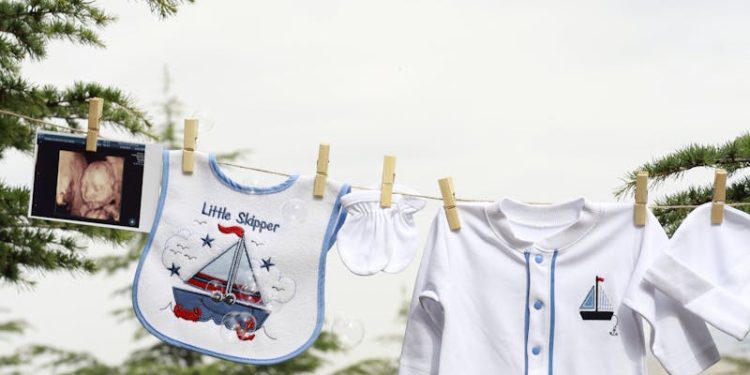Hand-me-down baby clothes are an invaluable resource for parents—they save money, reduce waste, and come with sentimental value. Whether you’re passing down clothes between siblings, receiving them from friends, or planning to save your baby’s clothes for future use, it’s important to know how to store and care for them properly. Proper care not only keeps the clothes in good condition for the next baby but also ensures they are safe and clean for your little one. In this guide, we will explore practical tips for storing and caring for hand-me-down baby clothes to make the most of these treasured items.
1. Sorting Hand-Me-Down Baby Clothes
The first step in caring for hand-me-down baby clothes is to sort them properly. Go through each piece and categorize clothes based on size, season, and condition. Sorting clothes this way makes it easier to store them and locate what you need when the time comes.
- Check for Damage: Before storing or passing on baby clothes, carefully check each item for any damage, such as stains, tears, or missing buttons. Clothes with minor issues can often be repaired, while those that are too worn out should be discarded or repurposed.
- Separate by Size and Season: Organizing clothes by size and season will make it much easier to find the right items when you need them. Labeling each group will also help you identify clothes quickly.
2. Properly Washing Hand-Me-Down Clothes
Before storing hand-me-down clothes or passing them on to someone else, it’s essential to wash them properly to remove any dirt, stains, or odors. Proper washing also helps eliminate bacteria, dust mites, and allergens, which is especially important for a newborn’s sensitive skin.
- Use a Gentle Detergent: Choose a detergent that is free from dyes and fragrances, as these can be irritating to a baby’s delicate skin. A hypoallergenic detergent is a great choice for ensuring that the clothes are safe for the next baby.
- Treat Stains: Pre-treat any visible stains before washing. A gentle stain remover or a paste made of baking soda and water can work wonders on stubborn spots. Make sure the stain is completely gone before storing, as stains can set in over time.
- Avoid Fabric Softeners: While fabric softeners may leave clothes feeling soft, they can also leave residues that may irritate sensitive skin. Instead, opt for a half-cup of white vinegar in the rinse cycle, which naturally softens clothes and removes detergent residue.
3. Storing Hand-Me-Down Baby Clothes
Proper storage is key to keeping baby clothes in good condition until they are needed again. Follow these tips to store your baby clothes safely and effectively:
- Choose the Right Storage Containers: Use airtight plastic bins to keep baby clothes protected from dust, moisture, and pests. Clear bins are ideal, as they allow you to see the contents without having to open them. Alternatively, vacuum-sealed storage bags are a good option for saving space.
- Label Each Bin: Clearly label each bin with the size and season of the clothes inside. This will save you time when you need to find the right clothing later on.
- Add Cedar Blocks or Lavender Sachets: To help prevent pests like moths from getting into the clothes, consider adding cedar blocks or lavender sachets to your storage bins. These natural deterrents keep pests away without the use of harmful chemicals.
- Store in a Cool, Dry Place: Make sure to store baby clothes in a cool, dry area, away from direct sunlight. Heat and moisture can lead to mold growth, while sunlight can cause fabrics to fade over time.
4. Tips for Handling Stains and Odors
Even with the best storage techniques, hand-me-down baby clothes may sometimes develop stains or odors over time. Here are some tips for freshening them up:
- Sunlight for Stains: If you notice yellowing or stains on stored clothes, try hanging them outside in the sunlight. Sunlight is a natural bleach that can help to lift stains without the use of harsh chemicals.
- Baking Soda and Vinegar: For clothes that have developed an odor, wash them with a cup of baking soda or add a half-cup of white vinegar to the rinse cycle. Both of these household items help neutralize odors naturally.
5. Repairing Hand-Me-Down Baby Clothes
Small repairs can go a long way in extending the life of baby clothes. Before storing clothes, check for loose buttons, small tears, or frayed hems.
- Sew Loose Buttons: Make sure all buttons are securely sewn on. It’s a quick fix that can prevent buttons from falling off and becoming a choking hazard.
- Patch Small Tears: Small holes or tears can be patched up easily with a needle and thread. You can even use iron-on patches for a faster solution.
6. Repurposing Worn-Out Baby Clothes
If some baby clothes are too worn out to be passed down, consider repurposing them rather than throwing them away. Old onesies can be cut up and used as cleaning cloths, while soft cotton shirts can be turned into reusable baby wipes.
For clothes with sentimental value that are no longer wearable, consider turning them into a quilt or a memory pillow. This is a creative way to preserve the memories associated with those early baby days.
7. Passing Hand-Me-Downs to Others
Hand-me-downs are a wonderful way to help other families, and properly preparing clothes before passing them on ensures they are appreciated and used.
- Wash and Fold: Make sure all clothes are clean and neatly folded before passing them on. This gesture shows that you care about the recipient and ensures that the clothes are ready to wear.
- Package by Size and Season: Group clothes by size and season, and label them accordingly. This makes it much easier for the recipient to find what they need without sorting through everything.
8. Benefits of Hand-Me-Down Baby Clothes
Hand-me-down baby clothes are not only budget-friendly but also environmentally beneficial. By reusing baby clothes, you’re helping to reduce the demand for new clothing production, which in turn reduces waste, conserves resources, and lowers carbon emissions.
Using hand-me-downs also creates a sense of community. Whether you’re passing clothes between siblings, cousins, or friends, these shared items carry stories and memories that can be cherished by multiple families. This practice promotes sustainability while also building connections and sharing the joy of raising little ones.













